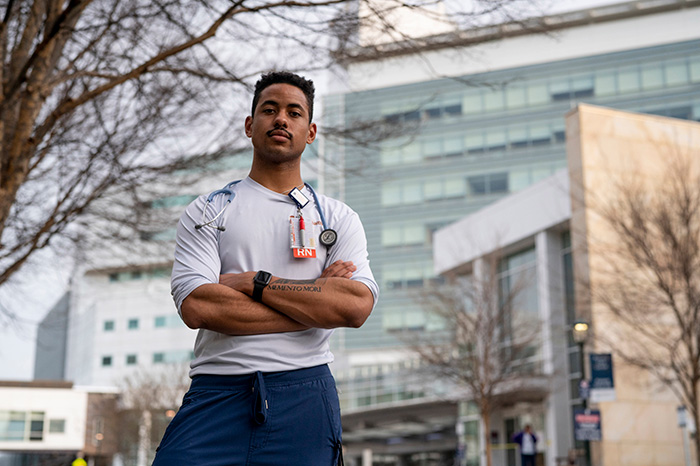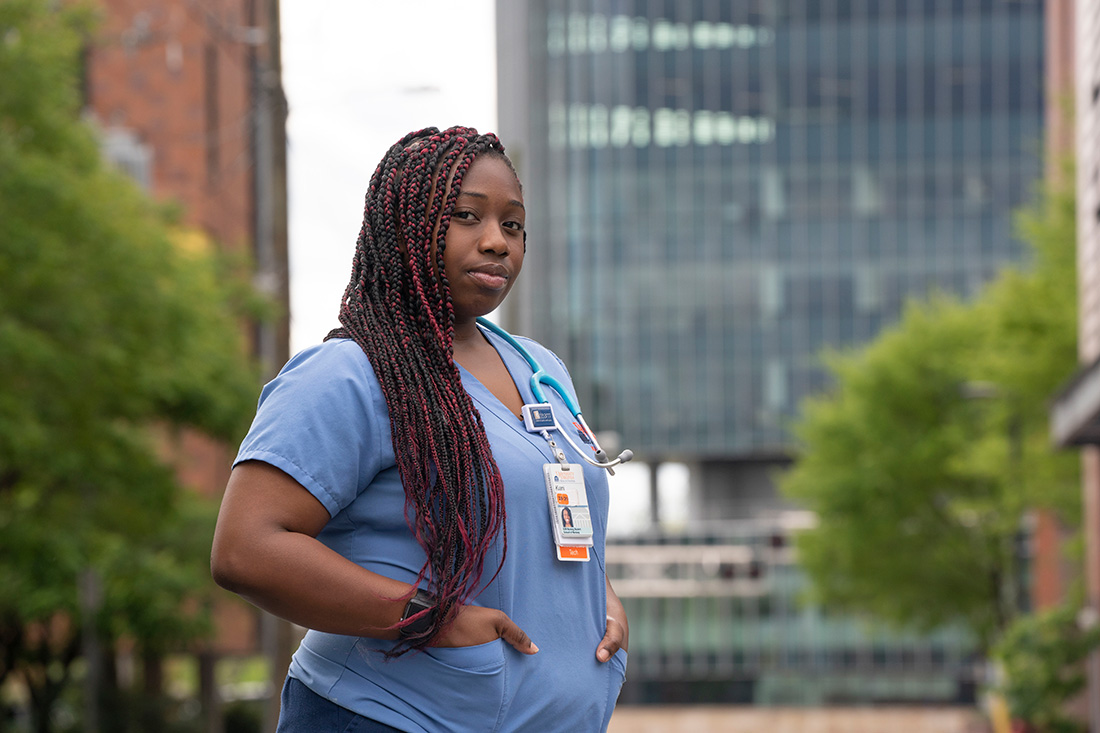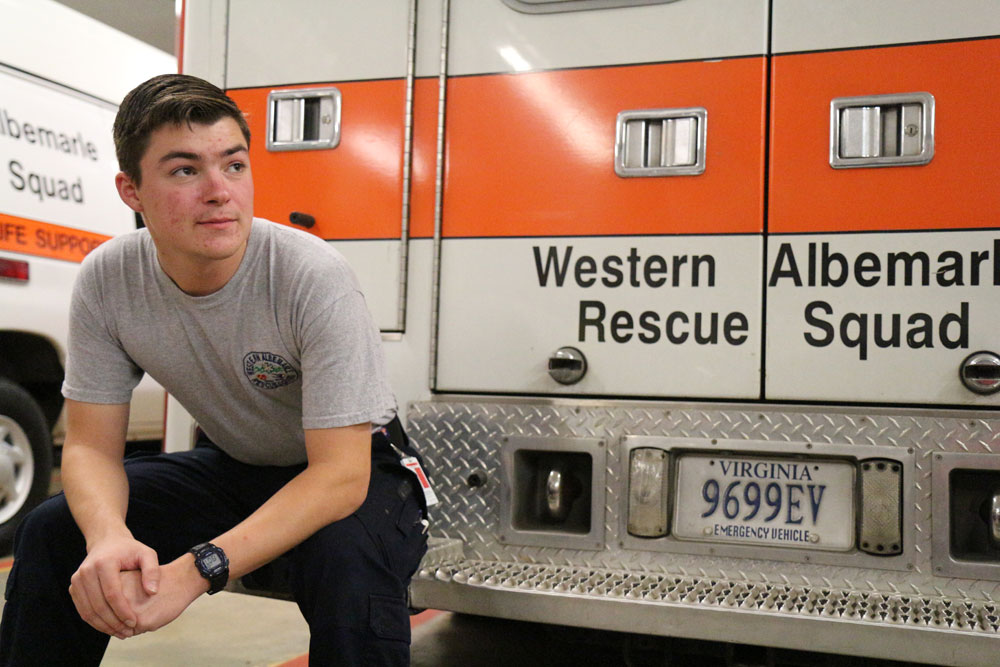
Resilience in the Time of COVID
It was Saturday evening before his shift in the ER, and Billy Burris (BSN `19) was thinking about his coronavirus bag.
In it, he’d have “extra scrubs, some extra clothes,” he figured aloud as he walked the roughly mile-long journey to work on a beautiful spring Saturday on Charlottesville’s largely deserted streets. “If I get exposed, I’d make plans to spend the night with some of my other exposed co-workers, and text my roommate that he’d have to go stay with his parents in Virginia Beach.”
It was the latest attempt to assemble a plan in what had become a dramatic, un-plannable-for month. For the previous three, the novel coronavirus had swept across Asia, then Europe, sickening and killing hundreds of thousands before it arrived in the United States and rapidly spidered across the country. On this penultimate day in March, Maryland was the latest state to issue a stay-at-home directive, something Virginia’s 8.5 million residents had already been doing for more than a week. The $2 trillion stimulus plan had just been ratified by both the House and Senate to provide relief from the flattened economy. A record-setting 13 million Americans had filed for unemployment.
“You know it’s going to be bad. You know it’s coming. That’s what this is like.”
Billy Burris (BSN `19), UVA Health emergency department nurse
And the virus’s toll had already been immense. By mid-April, more than 550,000 Americans had contracted the virus, and nearly 22,000 were dead. New York—now walled off from much of the outside world—accounted for nearly half of the nation’s deaths, while newer hotspots in Louisiana, Michigan, and Massachusetts were experiencing more cases.
Burris—who’d been quarantined in his apartment for 14 days after a mid-February trip to the Netherlands had come to a screeching halt—was back on nights in the ER at UVA Health. His significant other, a non-citizen, couldn’t return to the United States and local friends working in restaurants and in retail were furloughed, and worried sick about how they’d pay May’s rent.
Burris himself was acclimating to other changes coronavirus had brought. The ER smelled a bit like tequila, he said, thanks to a donation of hand sanitizer from a local distillery. Protocols had expanded. Coworkers were on edge. And things that had been simple pre-pandemic now required careful consideration and extra steps.
By early April, anyone arriving to UVA Health’s ER who flagged for COVID-19 symptoms—including headache, nausea, diarrhea, chills, as well as fever, cough, aches, sore throat, and runny nose—required care from clinicians outfitted in full protective gear. Though the overall patient count in the ER was as low as Burris had ever seen it, the extra protocols took extra time and getting used to, and invariably complicated every interaction. If you suited up and then forgot an instrument outside a patient’s room, Burris said, it could be hard to get a colleague to lend you a hand because everyone else was busy, too.
“Sometimes it feels like everyone else is in a room,” Burris said, “and we’re all trying to get someone to hand us something.”
Even with the break in patient numbers, those who did arrive at the ER were more gravely ill than before, and Burris felt uneasy about what he was sure was a coming storm of sick people in increasingly dire need.
It made him recall driving cross-country from Virginia to Oklahoma with his twin brother several years back.
“The landscape is so open there, so flat, you can see a thunderstorm from miles away, and you can hear it, too,” he said. “You’re not there yet, you’re 20 to 30 minutes away, but you can see those storm cells. You know it’s going to be bad. You know it’s coming.
“That’s what this is like.”

“MORE EAGER THAN FEARFUL”
Nursing students are quickly emerging into a profession on the frontlines of the COVID-19 pandemic. That fact has not, by and large, made them wonder why they chose nursing so much as it’s reinforced why they have.
“It’s definitely made me want to become a nurse even more,” said third-year student Martha Peterson, who left Grounds March 19 when the University announced dorms would close, and has been at her parents’ home near Baltimore ever since. “All this has also given me a greater appreciation of nursing, too. If it’s for the greater good, and helps people survive, the risks are really worth it.”
Even as students’ plans came to a screeching halt, they’ve done their best to adjust.
“It's definitely made me want to be a nurse even more.”
Martha Peterson, third-year BSN student
“I felt like I was in my prime time, coming into my fourth year, before everything just stopped,” said Reanna Panagides (BSN `20), who’s reoriented the research project she’s doing with assistant professor Emma Mitchell that’s focused on a sexual health peer support program in Honduras remotely, from her home in Sterling, Va., while commuting back and forth to work at UVA Health on weekends. “But I’ve tried to take a positive outlook, continue the research projects remotely, and just try to have an impact on the world while also trying to social distance.”
For those like Panagides in the class of 2020—many of whom will graduate early and be eligible to take the NCLEX licensing exam in Virginia early, due to a fast-tracking of their graduation status and the required letters of attestation needed to cake the nurse licensing exam, called the NCLEX—the itch to get to practice is keen even as the fear of unknowns looms large.
That’s true for Kiani “Kiki” Hudgens (BSN `20), who’s worked throughout her time at UVA as a patient tech, and lately on the Special Pathogens Unit prepping nurses caring for COVID-19 patients. Hudgens, from Orange, Va., was disappointed when her fourth-year practicum at Mary Washington Hospital was cancelled but said her part-time work at UVA Health tempered her fears by keeping her busy, even though it’d forced her to remain apart from her family, many of whom live locally.


“I keep thinking about something I remember hearing as a counselor at a summer camp years ago,” said fourth-year Ryan Thomas, who begins work in the surgical trauma intensive care unit at UVA Health this September, if not sooner. “The camp director told us, ‘Life starts at the edge of your comfort zone.’ So, in some way, maybe that’s the end goal here: becoming more comfortable with being uncomfortable.”
“Maybe that’s the end goal here: becoming more comfortable with being uncomfortable.”
Ryan Thomas (BSN `20), a paramedic, who will soon begin work in the surgical trauma intensive care unit at UVA Health
Even apart from their fears, students say the abrupt losses they’ve experienced—of their college days, of friendships cut short, of ceremonies missed, and worries compounded—are painful. But some, like Hudgens, say that they appreciate the care with which faculty delivered the difficult news, pieces of which often came incrementally. Nursing faculty took care, she said, to virtually gather students to address the changes, assuage their concerns as best as they could, and continuously offer both support and solace.
“It’s not always about academics here,” said Hudgens. “It’s making sure we’re OK, which makes coming to terms with all of this a bit easier. And now that I’ve seen a COVID patient, it really makes me realize how serious the situation is, and why everything is being cancelled. It’s for everyone’s safety, so I understand that part of it, too.”
“The School has really adopted this idea of resiliency and helped us cultivate this skill to be able to change and respond,” added Panagides, founder of the student group Perennials for Patients who, during quarantine, cultivated a new garden of kale, cauliflower, and Thai basil on her parents’ back deck. “We’ve really used these skills in a time where everything is changing fast and requires us to very quickly adapt.”

“FULFILLMENT OF A PROMISE, AND A REMINDER”
So how does a school renowned for being close-knit, caring, and an exemplar of a healthy work environment evolve in an era when physical distancing and remote learning are the new normal? And how might it care for students, faculty, staff—even its alumni—while also being strict in its enforcement of the rules?
Days into the pandemic, the Compassionate Care Initiative (CCI) led the way. Before COVID-19, CCI offered multiple drop-in sessions most days; a regular battery of yoga, art, meditation, retreats, and other activities. Pivoting in the week after UVA closed, CCI held its first virtual drop-in — Zoom office hours with Kenny, the therapy dog, a session led by mental health nursing professor Edie Barbero — and the following week transitioned other live drop-ins to the Zoom platform, too.
5x/week
By the end of March, the Compassionate Care Initiative offered a live, virtual drop-in classes every day of the week.
“In light of the crisis and all the emotions it stirred, getting these offerings running online was critical,” said Lili Powell, the Maria and John Kluge Endowed Chair in Compassionate Care and interim CCI director, who, with assistant director Hannah Crosby, migrated CCI offerings into the virtual realm. “Their transition online was fulfillment of our promise, and a reminder: resilience matters.”
CCI quickly transformed its website into a hub for compassionate care, posting live, virtual drop-in classes in yoga, guided meditation, even tai chi, while also featuring information for healthcare workers in Stress First Aid, a peer support system championed by professor Richard Westphal. The CCI also deepened its alliance with the UVA Mindfulness Center, which, through CCI, now offers daily ‘Mindful Pauses,’ and strengthened its ties to the Center for Appreciative Practice, UVA Health, and the University as a whole.
Faculty, like assistant professor Natalie May and professor Julie Haizlip, wrote and circulated essays about the power of positivity, and encouraged their students to tame their stress through self-expression, even assigning COVID-related haiku. Many faculty members began their live online courses March 27 spending time talking with students, now at a distance, about what had happened, how they were feeling, what they’d experienced, and how, against fear, change, and loss, they were coping.
Some might have anticipated that online courses would be chilly expanses in the internet ether, with little discussion or the back-and-forth pondering that happens when a group gathers physically in a learning space. Not so. Once acclimated to Zoom, the now-common online learning platform used by the School and University, faculty, students, and staff discovered things about one another that actually brought them closer.
Children and toddlers would meander into view. Pets would wander across keyboards, jump in laps, or need to be let out into the yard. People noted one another’s décor and found they could connect online in a way that many found deeply meaningful and often personal.
94
Number of courses for spring 2020 that were migrated online
Meghan Mattos (COLL `06, MSN `09), an assistant professor who, with professor Kathryn Reid, teaches the Quality, Safety, and Evidence-Based Practice class to 44 third-year BSN students, discovered the tinny voice of her six-year-old daughter singing in the background of one of her recorded lectures. Though Mattos and Reid’s class is asynchronous so as to be accessible—a process that’s helped Mattos “chunk” lectures into smaller, more digestible bits, and answer frequently asked questions that arise—she’s also found she’s gotten to know her students on a deeper level during small group or one-on-one Zoom office hours, and revealed a part of herself, too.
“I really like to take that time to ask how they’re doing,” said Mattos, “and that usually leads to a discussion about how I’m doing, too. I really want them to know that I’m accessible, and here for them. We definitely know more about one another personally than if we were in the classroom.”
That intimacy has also been true for assistant professor Virginia LeBaron, who teaches a research methods doctoral seminar, and began seeing students individually after her weekly live Zoom course ended. She’s found the one-on-one sessions to discuss assignments particularly rewarding.
“There’s no substitute for face-to-face,” noted LeBaron (BSN `96), “and I know students wouldn’t necessarily have chosen this, but we’re all making it work. People have been engaged. They ask questions. And seeing people in their natural habitat—a cat walks by, someone has to care for a child—it’s added context and an element of humanity that’s been nice in a really stressful time for us. For me, it’s an unexpected benefit.”
"We definitely know more about one another personally than if we were in the classroom.”
Meghan Mattos, assistant professor, of the intimacy afforded by her online teaching and advising
Others, like professor Kim Acquaviva, the Betty Norman Norris Professor of Nursing, accommodated students’ schedules with asynchronous discussions in Collab (an intranet site) that were accessible anytime and that students could “jump in and out of” during the week.
Such a format “means a lot gets covered,” explained Acquaviva, whose recent prompt—Take a look beyond the evolving COVID-19 pandemic. What microeconomic, macroeconomic, and/or political legacy will COVID-19 have? What opportunities or challenges will arise in relation to the nursing profession?—elicited 227 responses among the 47 students over just three days. “What’s fascinating is how students take ideas deeper, and build on information learned in other classes, which definitely enriches the discussion.”
She also noted that the move online helped more reticent students find their voices, while at the same time giving those adept at expression powerful writing practice.
“They’re going deeper in terms of their thoughts and writing in ways that are a lot more realistic to how people do it in real life,” said Acquaviva. “And they’re practicing communicating their ideas and collegial, thoughtful, reasoned debate and discussion in writing that will hold them in good stead in the workplace.”
In all, 94 spring courses went online. Few technical hiccoughs, thanks to close instruction from an in-house Zoom platform mentor and instructional designer Kevin Tressler, meant the tech was tamed, and the teaching continued unabated.
“It’s really shown how adaptable we can all be,” noted LeBaron, “and it’s humbling and impressive how quickly people pivoted and pulled it together. I’ve been so impressed by how much grace has been extended on both sides; we’ve been gracious with each other. And it’s a bright spot in all of this, to see that play out.”
“The students have really risen to this occasion,” said Mattos, who was recently brought to tears when she received a thank-you email from a student. “I feel like we’re all trying so hard . . . so to receive positive feedback from a student who took the extra time was the highlight of my day, my week, even of the class so far.
“They really care and want to do well. And it’s easy as a professor to want to do the very same in return.”
WHAT’S BEEN TAKEN; WHAT’S BEEN GAINED
For many students, including fourth-year Meredith Bond (BSN `20), COVID-19 has taken something away even as it’s given back something else, especially for nurses like her on the cusp of practice.
On Bond’s final day in her Lawn room No. 19 March 18, after she cleaned, tuned into the Centers for Disease Control’s coronavirus briefing, hid something in the secret compartment beneath her floorboards for the next occupant to find, as is Lawn tradition, and bid her fellow Lawnies goodbye, she struggled to manage her emotions.
Living on the Lawn “was a once-in-a-lifetime opportunity,” said Bond, originally from Atlanta, Ga., who begins work this summer at Children's Healthcare of Atlanta in the pediatric ICU. “I never imagined that I’d be able to open up my door to such a historic piece of land, especially in the morning before clinicals, maybe before the sun is even up, or on a mid-70s day. This is all so weird, and there have been so many abrupt changes. And I’ve been looking forward to spring on the Lawn. And I won’t get that.”
“The School has taught us so much about resilience . . . and that’s something that everyone needs right now, and we know so much about it. Not every nursing school has that. That’s something we have, and can take into the field, and demonstrate through our practice."
Meredith Bond, a 4th year BSN student who begins work in the pediatric ICU at Children's Healthcare of Atlanta this July
Then she paused and smiled.
“But I think this is such an important time for us to be going into the nursing field, and taking that initiative to be leaders,” Bond continued. “The School has taught us so much about resilience in the past 3.75 years, and that’s something that everyone needs right now, and we know so much about it. Not every nursing school has that. That’s something we have, and can take into the field, and demonstrate through our practice.
“It’s an example of how much medicine and healthcare changes, and how you’re involved in that. It’s such a big thing to look forward to.”

